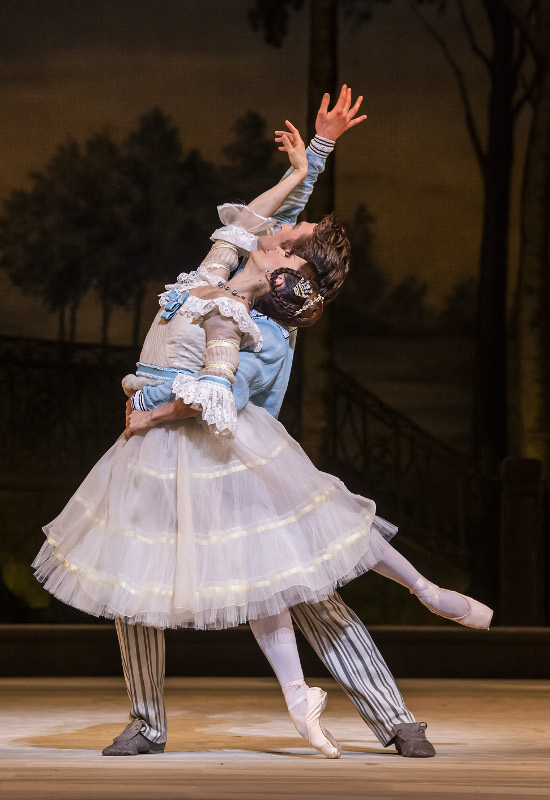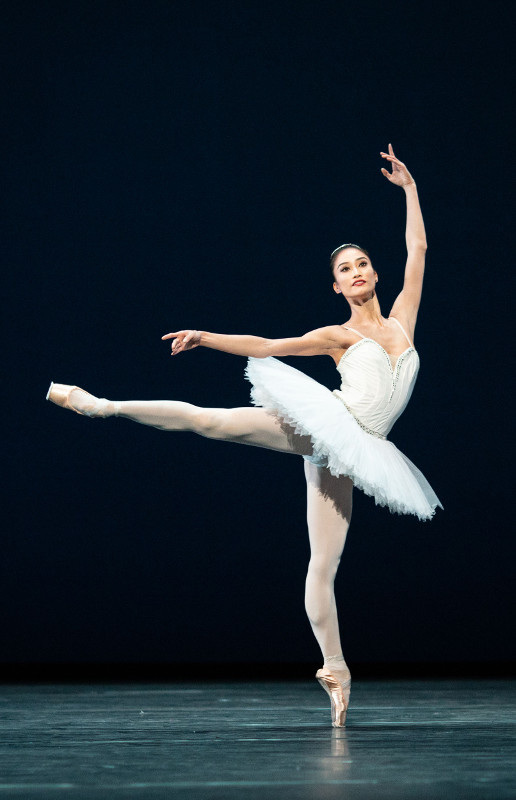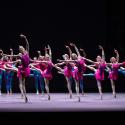You can’t accuse the Royal Ballet of lightweight programming: the three juicy pieces in the triple bill that opened at the Royal Opera House on Tuesday add up to a three-hour running time. That’s a lot of ballet for your buck. Whether they actually go together is another question. Russian-ness is a rather tenuous thread to link the mythic extravaganza of The Firebird, the torrid claustrophobia of Ashton's Month in the Country and the faceted neo-classicism of Balanchine's Symphony in C.
 A Month in the Country, Frederick Ashton’s throbbing little ode to forbidden passions running high in a Russian summer, is all about the central casting: get it right and you have a chamber tragedy; wrong and it's mere bourgeois histrionics. Tuesday's performance was let down by the lack of chemistry between Marianela Nuñez as a bored country lady and Matthew Ball as her son’s too-attractive tutor (pictured right). Nuñez inhabits Natalia's forced butterfly gaiety all right, but Ball slouches around accepting the amorous approaches of every female in the house like an entitled varsity sportsman rather than a poor-but-educated young hopeful caught precariously between love and position. Without that authentic central spark their affair never properly catches fire, except very briefly in the main pas de deux where the power of Ashton's passionate choreography seems to break down some barriers. Strong supporting work from the rest of the cast, including a scene-stealing turn from gorgeously musical Francesca Hayward as the disregarded ward Vera, is not enough to make this Month seem profound.
A Month in the Country, Frederick Ashton’s throbbing little ode to forbidden passions running high in a Russian summer, is all about the central casting: get it right and you have a chamber tragedy; wrong and it's mere bourgeois histrionics. Tuesday's performance was let down by the lack of chemistry between Marianela Nuñez as a bored country lady and Matthew Ball as her son’s too-attractive tutor (pictured right). Nuñez inhabits Natalia's forced butterfly gaiety all right, but Ball slouches around accepting the amorous approaches of every female in the house like an entitled varsity sportsman rather than a poor-but-educated young hopeful caught precariously between love and position. Without that authentic central spark their affair never properly catches fire, except very briefly in the main pas de deux where the power of Ashton's passionate choreography seems to break down some barriers. Strong supporting work from the rest of the cast, including a scene-stealing turn from gorgeously musical Francesca Hayward as the disregarded ward Vera, is not enough to make this Month seem profound.
Balanchine’s Symphony in C is the perfect marriage of music and movement: sparkling with neo-classical choreographic invention (and rhinestones) to match Bizet’s mood-lifter of a symphony. Last night’s cast took the opening movement just a shade too slowly — it should fairly crackle along — but Vadim Muntagirov’s big jumps and bigger smile were a joy, as always and Fumi Kaneko (pictured left) made a classical and composed debut as his partner, stepping in at the last minute to replace an injured Natalia Osipova. Sarah Lamb's coolly correct Andante pas de deux with Nicol Edmonds would have benefited from slightly less composure to bring out its White Swan resonances; Symphony in C may be an abstract ballet, but this movement has a story worth telling. Francesca Hayward's musicality shone again in the final allegro vivace, a whole-company celebration that cannot fail to raise a smile, even if — like the first movement — it could have been attacked with slightly more brio.
Perhaps surprisingly, The Firebird was the standout performance of the evening. Fokine and Stravinsky’s Ballets Russes classic can verge on the ridiculous, with its myriad ‘monsters’ in lavishly outré costumes, but in the Royal Ballet’s hands, it is cool, mysterious and never histrionic. Willowy Yasmine Naghdi was wild and dignified in the Firebird role, and Christina Arestis as the Beautiful Tsarevna and Edward Watson as Ivan Tsarevitch heroically managed to bring some feeling to their mainly symbolic roles. The 12 enchanted princesses were a cool white tonic to the eyes in Fokine's gorgeous character dance with its inventive tableaux (a sloping stack of princesses; why not?) and the house woodwind section brought thrilling life to the witchy woodland soundscape of Stravinsky’s score.
Natalia Goncharova's designs deserve much of the credit for making The Firebird so magical: they certainly whet the appetite for her big retrospective at Tate Modern, which opens today. In the first section, a subtly shimmering darkness perfectly foregrounds the fiery colours of the bird and the Tsarevitch; in Khostcheï's court we marvel at a gobsmacking panoply of colours and shapes that shouldn't work together (rose and russet!) but do; while the final scene celebrates the coronation of the Tsarevitch and Tsarevna with harmonious extravagance — several dozen additional spear-carriers are needed just for this short scene — in front of a truly splendid backcloth of a city of churches.
These three very different pieces may make slightly odd bedfellows, but that’s only a small quibble to set against a programme abounding in quality as well as quantity of dancing.














Add comment